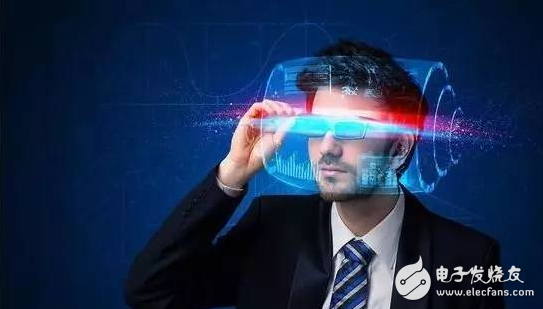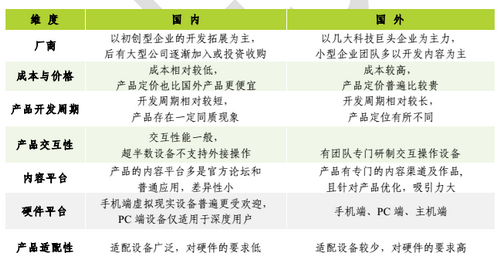The Ministry of Industry and Information Technology "Virtual Reality Industry Development White Paper 5.0" uses more than 14,000 words to describe the current development of China's virtual reality industry, and puts forward relevant policies. The virtual reality industry has been fully affirmed at the national level, which is worthy of serious study by VR practitioners.

Foreword
The information industry is a basic, strategic and leading industry of China's national economy. It has important demonstration significance for China's economic restructuring and is the main battlefield for steady growth and reform. China is a leading information industry country in the world. A number of innovative products with good market response and good user experience, represented by virtual reality and other products, have promoted supply-side reform and become an important means to improve the effective supply capacity of consumer electronic products.
Virtual reality technology originated in the 1960s, which means creating a three-dimensional environment with computer systems and sensor technology to create a new way of human-computer interaction by mobilizing users' various senses (visual, auditory, tactile, smell, etc.). Enjoy a more realistic, immersive experience. With the improvement of hardware performance and the significant reduction of cost, virtual reality products have been widely developed in recent years. Especially at the 2016 Consumer Electronics Show in the United States, virtual reality products have become the absolute protagonists of the exhibition.
Under the guidance of the Electronic Information Department of the Ministry of Industry and Information Technology, the China Electronics Technology Standardization Institute organized the White Paper on the Development of Virtual Reality Industry. This white paper comprehensively describes the development status, technical characteristics, key technical links and main application fields of the virtual reality industry at home and abroad, and analyzes the future improvement space and gives corresponding policy recommendations. Finally, some typical virtual reality products that have been released at home and abroad are listed.
The main drafters of this white paper: Liu Huayi, Wang Li, Shan Lei, Yang Zhen, Jia Bowen, Zhao Xiaotong, Zhang Subing, Sun Qifeng, Distance, Wang Cong.
table of Contents
I. Overview of the development of virtual reality 4
(I) Development of China's virtual reality industry 4
(II) Development of the international virtual reality industry 5
(III) Virtual reality standardization situation 7
Second, virtual reality technology features 10
(1) Technical Overview 10
(2) Virtual reality industry chain 12
(III) Evolution direction of virtual reality technology 13
(4) Bottlenecks in virtual reality technology and urgent need to solve problems 16
Third, the application of key areas 19
(1) Military field 19
(2) Game entertainment field 19
(3) Medical field 20
(4) Industrial field 20
(5) Education and culture fields 21
Fourth, China's virtual reality improvement space 21
(1) Need to improve hardware performance to support rapid data processing 21
(2) Need to improve the application of the ecological environment to expand the scope of application 22
(3) Need to strengthen public services to solve common problems in the industry 23
V. Policy recommendations 23
(1) Plan the layout in advance to make the top design 24
(II) Promoting industrialization and industrial application 25
(III) Strengthening culture and brand building 27
Attachment: Some typical product representatives 29
(1) Ant View (VR Helmet) 29
(2) Shenzhen 3Glasses (VR helmet and all-in-one) 33
(3) Musical friends (one machine) 34
(4) LeTV (Mobile VR Helmet) 35
(5) HTC (VR helmet) 36
(6) Samsung (Mobile VR Helmet) 36
(7) Sony Morpheus (VR helmet) 36
(8) Microsoft HoloLens (AR Helmet) 36
(9) Oculus Rift (VR helmet) 36
I. Summary of the development of virtual reality
Virtual reality technology is a computer simulation system that creates a new interactive system through the simulation of the three-dimensional world. It uses a computer to generate a simulation environment, which is an interactive 3D dynamic view and entity behavior system simulation of multi-source information fusion, and immersed users in the environment. In the industry, virtual reality is defined as three types of technology applications: virtual reality (VR, Virtual Reality), augmented reality (AR, Augmented Reality) and mixed reality.
(MR, Mixed Reality). In fact, in the division of academia, mixed reality technology is divided into two categories: augmented reality and enhanced virtual environment (AVE, Augmented Virtual Environment).
(1) Development of China's virtual reality industry
According to the Outline of the National Medium- and Long-Term Science and Technology Development Plan (2006~2020), virtual reality technology is one of the three major technologies in the information technology part of cutting-edge technology. Focus on multidisciplinary technologies such as electronics, psychology, control science, computer graphics, database design, real-time distribution systems, and multimedia technologies, and research in various fields such as medicine, entertainment, art and education, military and industrial manufacturing management. Virtual reality technology and systems.
Since the 1990s, China has paid great attention to the research and application of virtual reality technology. Due to technical and cost constraints, the main application targets are military and high-end commercial applications. Products suitable for ordinary consumers have only been in chip, display and human-computer interaction in recent years. The development of technology has gradually entered the market.
At present, China's virtual reality enterprises are mainly divided into two categories. One is mature
The industry penetrates into the virtual reality field based on traditional hardware and software or content advantages. Among them, smartphones and other hardware manufacturers mostly come from hardware layout. For example, the portable device developed by Lenovo and AntVision is a virtual reality glasses; Meizu and Extension Technology cooperate to launch a virtual reality helmet for mobile phones. Game, animation producers or video publishing platforms are mostly cut from the software and content levels. In July 2015, iQiyi announced that it will release a non-commercial virtual reality application, which has already been initially adapted with some virtual reality vendors. Youyong Tuo, chairman and CEO of Youku Tudou Group, announced at the first Open Ecology Conference. Officially launched the production of virtual reality content. The second is a new type of virtual reality industry company, including eco-platform companies and start-up companies. This type of enterprise has a series of layouts in the fields of hardware, platform, content, and ecology, and is led by Internet vendors. Such as Tencent, Storm Technology, LeTV.
According to Ai Media Consulting, the market size of China's virtual reality industry in 2015 was 1.54 billion yuan. It is expected to reach 5.66 billion yuan in 2016. The domestic market size is expected to exceed 55 billion yuan in 2020. China's virtual reality industry is developing at a high speed.
(II) Development of the international virtual reality industry
As early as the 1990s, 3D games were already on the market, and virtual reality triggered similar attention at the time. For example, the game has Virtuality's virtual reality game system and Nintendo's Vortual Boy game console. The film has Lawnower Man, Virtuosity and Johnny Mnemonic. Book side
There are "Snow Crash" and "Disclosure". However, the virtual reality technology at the time did not keep up with the media's unrealistic imagination. For example, 3D games have poor picture quality, high price, time delay, and insufficient computing power. In the end, these products ended in failure because consumers were not satisfied with these technologies, so the first virtual reality boom faded.
In 2014, after Facebook acquired Oculus for $2 billion, a similar virtual reality fever hit again. In the past two years, the virtual reality/augmented reality field has made 225 venture investments with an investment of $3.5 billion. Digi-Capital data (December 2015) shows that in the past 12 months, companies have invested more than $1 billion in their investment in augmented/virtual reality. According to CBInsights, in 2014, the global virtual reality company's risk financing amounted to 775 million US dollars, an increase of more than 100% year-on-year, and 2015H1 realized financing amount of 248 million US dollars. Compared to the failures of the 1990s, the computing power of today's computers is strong enough to render the virtual reality world. At the same time, the performance of mobile phones has been greatly improved. In summary, current technology has solved many of the limitations of the 1990s. For this reason, some large technology companies are gradually participating.
Oculus chief scientist Michael Abrash said the company continues to develop technologies for touch, visual display, audio and tracking. This means that the VR/Augmented Reality product released in 2016 will begin to address the above issues and will continue to improve over the next three to five years. At present, the virtual reality industry is still in its infancy, and the supply chain and supporting facilities are still not
Mature, but the development prospects are imaginative, and the market potential is expected to be huge in the future. According to Digi-Capital, the virtual reality/augmented reality hardware and software market potential will reach $150 billion, and the compound growth rate is expected to exceed 100% in the next five years. According to game industry analyst firm Superdata, 70 million virtual reality heads will be sold by the end of 2017, bringing $8.8 billion in virtual reality hardware revenue and $6.1 billion in virtual reality software. According to TrendForce's latest forecast, the total market value of virtual reality in 2016 will be close to $6.7 billion. By 2020, if Apple joins, its value may be as high as 70 billion US dollars. From the forecast data of various consulting research institutions, virtual reality/augmented reality will achieve ultra-high growth in the next five years.

Table 1 Main differences between the domestic and international virtual reality industry in the development process
Introduction
SCOTECH`s Vacuum Pressure Impregnated Transformer (VPI transformer) is non-cast insulation that provides an excellent level of environmental production. The higher thermal class of insulation provides for a compact and reliable transformer from very lower power rating up to several MVA, VPI transformer can be supplied with either aluminum or copper windings. Our VPI transformer are used in many varied applications such as industrial, renewables, railways, marine, distribution and power generation.
Advantages
Perfect solution for low voltage transformer and inductors.
From IP00-IP56 with AN, AF, ANAF, or AFWF cooling
Reliable quality
Compact size
Scope of supply
Voltage level: up to 35KV
Rating level: up to 20MVA
Standards
SCOTECH`s dry type transformers are designed and manufactured in accordance with all major international standards (IEC, ANSI, UL, CSA etc.)
Why SCOTECH
Long history- Focus on transformer manufacturing since 1934.
Technical support – 134 engineers stand by for you 24/7.
Manufacturing-advanced production and testing equipment, strict QA system.
Perfect service-The complete customer service package (from quotation to energization).
Vacuum Pressure Impregnated Transformer
Vacuum Impregnated Transformer,Medium Voltage Dry Type Transformer,Vacuum Pressure Impregnated Transformer,Vacuum Pressure Impregnated Dry Type Transformer
Jiangshan Scotech Electrical Co.,Ltd , https://www.scotech.com